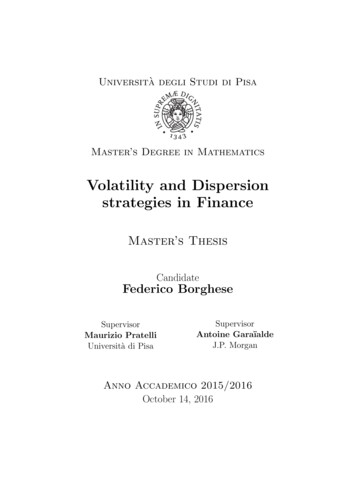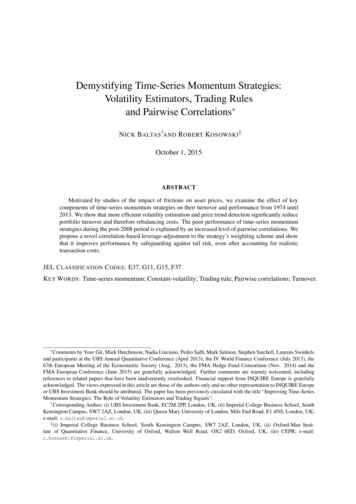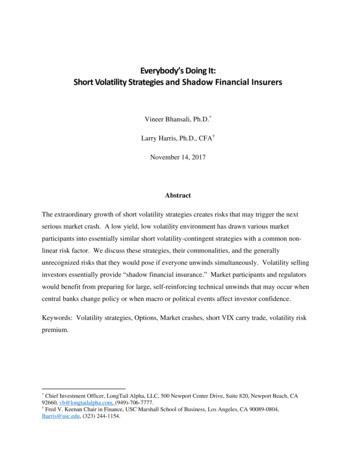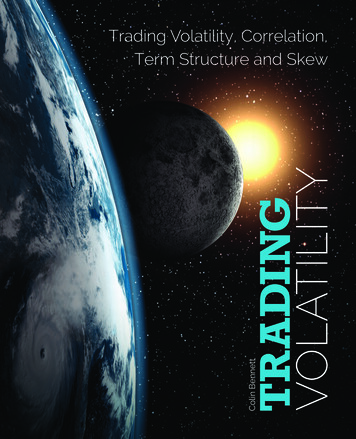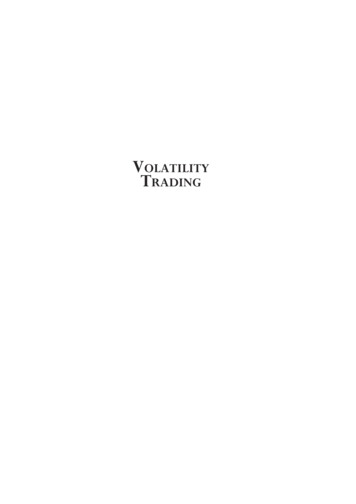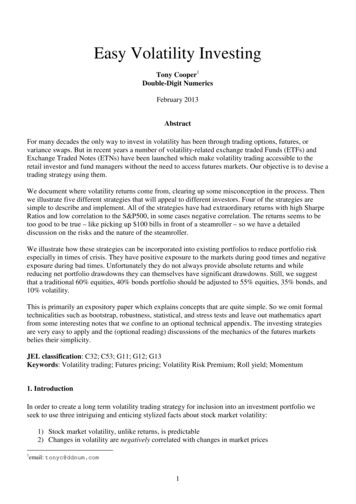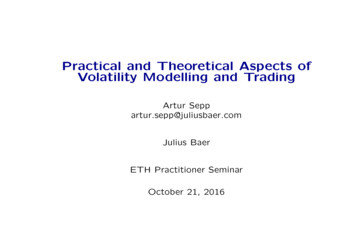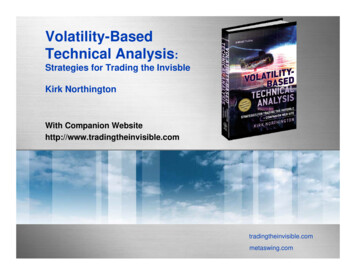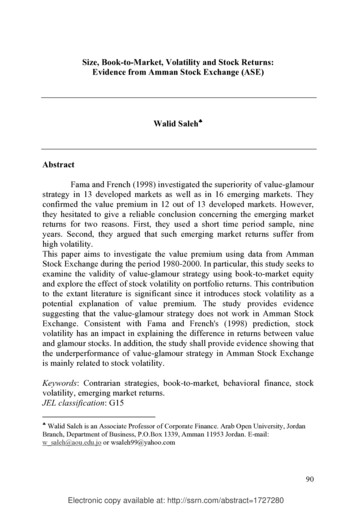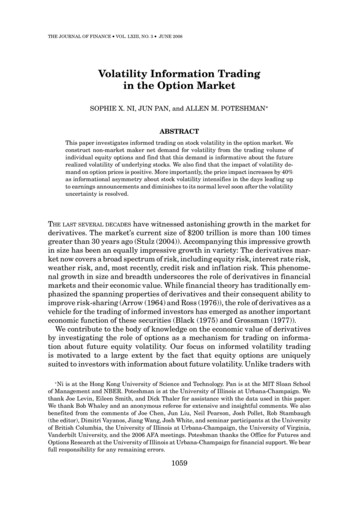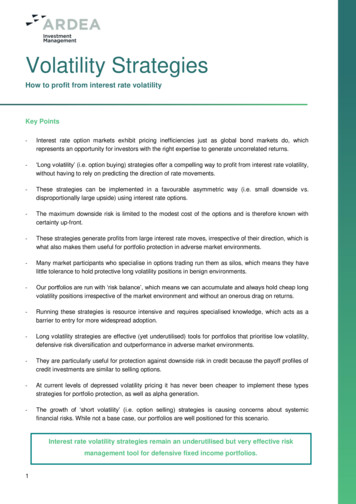
Transcription
Volatility StrategiesHow to profit from interest rate volatilityKey Points-Interest rate option markets exhibit pricing inefficiencies just as global bond markets do, whichrepresents an opportunity for investors with the right expertise to generate uncorrelated returns.-‘Long volatility’ (i.e. option buying) strategies offer a compelling way to profit from interest rate volatility,without having to rely on predicting the direction of rate movements.-These strategies can be implemented in a favourable asymmetric way (i.e. small downside vs.disproportionally large upside) using interest rate options.-The maximum downside risk is limited to the modest cost of the options and is therefore known withcertainty up-front.-These strategies generate profits from large interest rate moves, irrespective of their direction, which iswhat also makes them useful for portfolio protection in adverse market environments.-Many market participants who specialise in options trading run them as silos, which means they havelittle tolerance to hold protective long volatility positions in benign environments.-Our portfolios are run with ‘risk balance’, which means we can accumulate and always hold cheap longvolatility positions irrespective of the market environment and without an onerous drag on returns.-Running these strategies is resource intensive and requires specialised knowledge, which acts as abarrier to entry for more widespread adoption.-Long volatility strategies are effective (yet underutilised) tools for portfolios that prioritise low volatility,defensive risk diversification and outperformance in adverse market environments.-They are particularly useful for protection against downside risk in credit because the payoff profiles ofcredit investments are similar to selling options.-At current levels of depressed volatility pricing it has never been cheaper to implement these typesstrategies for portfolio protection, as well as alpha generation.-The growth of ‘short volatility’ (i.e. option selling) strategies is causing concerns about systemicfinancial risks. While not a base case, our portfolios are well positioned for this scenario.Interest rate volatility strategies remain an underutilised but very effective riskmanagement tool for defensive fixed income portfolios.1
IntroductionOne way to profit from interest rate volatility is to get directional calls right, ahead of a large move in rates.Sadly, we have yet to come across anyone who has been able to consistently get these directional callsright. Even the bond kings and macro gods who pride themselves on being able to foresee market swingshave struggled. (The bears come for the bond king, Masters of the universe struggle to read market)Getting market directional calls consistently right is just really hard, which is why our preference is toposition for market swings using non-directional interest rate option strategies.We’ve previously discussed how the large and liquid universe of global interest rate options offers a greatset of tools from which volatility strategies can be constructed to provide reliable downside protection forinvestment portfolios. (Refer - Volatility strategies are reliable risk diversifiers)At the same time, these markets are subject to the same pricing inefficiencies and inconsistencies that arepervasive across global bond markets, so they also offer uncorrelated alpha opportunities, with downsiderisk that is modest and known with certainty.We exploit these opportunities in a risk-controlled way using ‘long volatility’ strategies (i.e. option buyingstrategies), which can profit when markets start moving in any direction, while the maximum downside islimited to the modest cost of the options and is therefore known with certainty up-front.Just such an opportunity presented itself last quarter, culminating in a sharp repricing of interest rate optionmarkets in March, yielding profits for long volatility strategies.(The terminology section at the end of this article covers some of the unavoidable option jargon.)The Short VersionOption selling strategies – aka ‘short volatility’ strategies – generate returns by earning a premium (i.e. upfront payment) in return for selling options. The option seller’s profit potential is limited to the premiumearned but the loss can be unlimited.By contrast, given the defensive nature of our strategies it suits us very well to be on the other side ofthese short volatility strategies and it’s never been cheaper for option buyers like us to be ‘long volatility’.Long volatility strategies have a positively asymmetric payoff profile (i.e. downside limited to the cost ofbuying options vs. potentially unlimited upside), and can generate outsized profits when there are largemovements in interest rates, as there have been this quarter.Option sellers are effectively betting against tail risks i.e. infrequent but high impact market movements,which by definition don’t happen often. So their return profile tends to show periods of stable positivereturns (generated by earning option premiums), punctuated by short, sharp losses when large marketmovements impose losses.An example of such a loss occurred in February 2018, when short volatility strategies were badly hurt bythe sudden equity market sell-off and many ETF’s and other investment structures linked to the VIX indexcollapsed. (Refer - Investors burned as bets on low market volatility implode)Such strategies use to be the domain of a few specialists and only represented a niche allocation forinvestment portfolios. However, as years of ultra-low interest rates forced return chasing investors to takemore risk, these strategies have grown exponentially, even into products targeted at retail investors.A 2017 paper by Bhansali and Harris estimates the total AuM of short volatility selling strategies is about 1.5 trillion. (Refer - Everybody's doing it)Some believe the Feb-2018 VIX implosion was just a small taste of the volatility storm that could be2
unleashed if an unexpected market movement forces these strategies to unwind.Even back in 2013, the Dallas Federal Reserve stated the following;“Although selling volatility may seem like a simple, profitable idea, it carries risks that couldpotentially spread throughout the financial system. Given the growing popularity of this strategy,further investigation may be warranted to examine systemic issues arising from volatility selling.”(Refer - volatility selling strategies carry potential systemic cost)While short volatility strategies are a legitimate source of return, the risk vs. return characteristics can varygreatly over time as market conditions change, and as with any investment, it can be pushed too far whenlots of capital floods into the sector chasing returns.This is what’s happening now as the pricing of volatility in option markets has collapsed to very low levels,meaning option sellers are no longer getting as much compensation for the risks they’re exposed to.The flip side being it’s never been cheaper to run ‘long volatility’ strategies like ours.While we can’t know whether the growth of short volatility strategies will end up causing a crisis, we dosleep a lot better knowing that our portfolios are very well positioned if that was to happen.The Long VersionMost of the time option markets price in a positive ‘volatility risk premium’, which basically means impliedvolatility is materially higher than realised.(Refer to the ‘Options Jargon’ section below for definitions)Intuitively this makes sense because a rational option seller would need to be enticed by a risk premium tocompensate for taking the negatively asymmetric downside risk inherent in selling options.On the other side, option buyers are willing to pay this risk premium because they are getting insurancelike protection against large market movements that might hurt their portfolios.As with your home insurance, you expect there to be a cost for this protection, while the insurancecompany needs to earn a positive return for selling it to you i.e. on average, insurance premiums earned(akin to implied volatility) should exceed expected claim payments (akin to realised volatility).Option sellers are betting that future realised volatility will turn out to be lower than what is currently impliedby option prices. So, when the gap between implied and realised volatility is large, the volatility riskpremium is large and option sellers have a large safety cushion.The flip side being that option buyers are paying more for protection.However, just like with any financial market, changing demand-supply dynamics and market inefficienciescan cause these relationships to break down for periods of time.This is exactly what happened in US interest rate option markets over the past few months as realisedvolatility rose but implied volatility continued to decline, resulting in a smaller volatility risk premium.The chart below shows this divergence by comparing the MOVE index (Merrill Lynch Option VolatilityEstimate index), which measures implied volatility in US interest rates, to realised volatility on a 10 year USTreasury (i.e. govt. bond).3
Source: Ardea Investment Management, BloombergThe MOVE index is the bond market’s equivalent of the VIX equity volatility index. It tracks the annualisedimplied volatility (measured in basis points) from short term option prices referencing a basket of US govt.bonds. It basically reflects the option markets’ pricing of future expected volatility of the yields on thesebonds.After peaking in late Dec-2018, the MOVE index consistently declined all the way to late Mar-2019 (darkgreen line – implied volatility). What was unusual about this decline is that actual day to day movements inUS interest rates were increasing over this period (light green line – realised volatility).This kind of inconsistency (or market pricing inefficiency) doesn’t last indefinitely and eventually itcorrected, with implied volatility catching up to the increase in realised volatility, causing a big jump inoption prices and profits for long volatility / convexity strategies.These strategies generate profits from situations like this in two ways;1. As realised rates volatility rises the process of delta hedging allows consistent profits to belocked in, irrespective of the direction of interest rate movements.2. As market pricing of implied volatility rises the prices of options will rise, irrespective of thedirection of interest rate movements.(Refer to the ‘Options Jargon’ section below for definitions of delta hedging and convexity)As these profits are independent of market direction, they are an attractive source of uncorrelated alpha.Equally important, the downside risk in these strategies is always capped at the initial cost of buying theoptions.The current environment is particularly fertile for these long volatility alpha generating opportunitiesbecause implied volatilities across global rate markets are at historically low levels and getting close to thezero bound (unlike interest rates themselves, rate volatility can’t drop below zero).4
These dynamics of abnormally low market pricing of interest rate volatility and compressed volatility riskpremia used to be rare but are now becoming more common. Just as risk premia have shrunk in othermarkets like credit, the same has happened with interest rate options.Much has been written to explain this. The more widely cited possibilities include the anchoring of inflationexpectations, central bank buying of govt. bonds and ultra-low interest rates forcing yield seekers to boostreturns by selling options.But perhaps it’s just that low volatility begets low volatility.Prolonged low volatility conditions can create a self-reinforcing feedback loop resulting in option sellers,emboldened by the recent history of low volatility, being enticed into selling more options, which in turnreduces volatility further and generates profits for their short volatility strategies, in turn triggering yet moreoption selling.This dynamic typically works and works and works until it doesn’t. Eventually an external catalyst ofsome kind creates unexpectedly large market movements, which causes volatility to spike higher,triggering losses for option sellers and profits for long volatility strategies.To understand this, behavioural finance studies of ‘recency bias’ are useful. They find that investors tend tooveremphasise the importance of recent history at the expense of a broader perspective that would yieldmore balanced analysis. (Refer – WYSIATI)And indeed, current pricing of interest rate volatility seems more anchored to the recent history of benignmarket conditions than the potential for future uncertainty that it’s supposed to reflect.For investors with expertise in option markets, this represents a pricing inefficiency that can be exploited,not just to generate uncorrelated returns but also for defensive portfolio construction.‘Long volatility’ strategies offer uncorrelated alpha opportunities, with downside riskthat is modest and known with certainty.5
The Role of Long Volatility Strategies in Defensive PortfoliosLong volatility strategies are a very effective tool for fixed income portfolios that prioritise low volatility,defensive risk diversification and outperformance in adverse market environments.Such strategies generate profits from large interest rate moves, irrespective of their direction, which is whatmakes them reliable risk diversifiers that can protect investment portfolios from capital losses.For example, a large move lower in rates might occur in a recession scenario, while a large move higher inrates would accompany an inflation break out that forces central banks to hike rates aggressively. Bothscenarios would be negative for equities and credit investments, while the latter would also be negative forgovernment bonds.Therefore volatility strategies can be used for reliable protection in scenarios where conventional
Volatility Strategies How to profit from interest rate volatility Key Points - Interest rate option markets exhibit pricing inefficiencies just as global bond markets do, which represents an opportunity for investors with the right expertise to generate uncorrelated returns. - ‘Long volatility’ (i.e. option buying) strategies offer a compelling way to profit from interest rate volatility .
